Radioastron - the telescope of the future
400 years ago, Galileo made the first telescope out of a pipe and two glasses, and sent it to the sky. This was a breakthrough for humanity in the study of the universe. Over the years, research instruments have become more complex and expensive. They were created on the basis of the latest achievements in science, technology and in themselves became amazing engineering monuments. At the same time, they expanded the boundaries of knowledge and, at times, turned over all the ideas that mankind had. Now such devices, the advanced front of the science of space, can be counted on the fingers: Hubble telescope, Kepler exoplanet telescope, Chandra X-ray telescope, Curiosity on Mars, Cassini on Saturn. On Earth, it is worth adding the VLT, ALMA, and, probably, LHC telescopes. Perhaps I missed something, but now I’m absolutely certain that the Russian space radio telescope Spectr-R and the Radioastron project can rightfully be in this line.
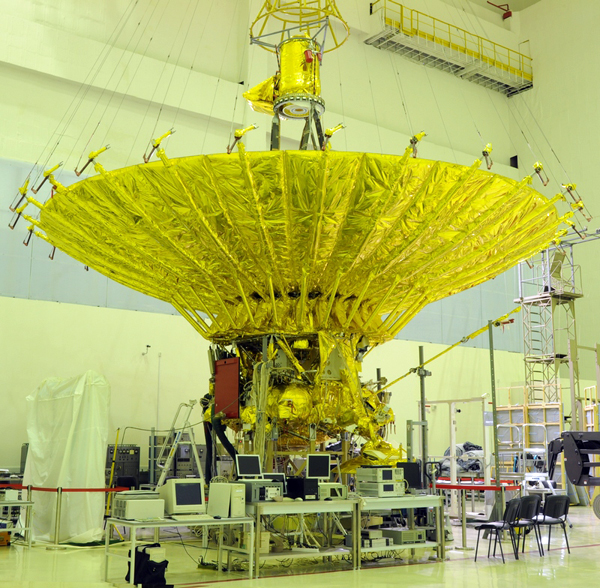
Almost two years have passed since its launch. All this time the preliminary scientific program was conducted. Soon it ends, and Spectrum-R will begin the main scientific program, which promises, if not to shake the universe, then to significantly expand its known boundaries.
May 23 in the NGO them. S.A. Lavochkin passed a scientific and technical council on the topic "Radioastron - the first scientific data." In fact, it was the report of the scientists who ordered the device to those who built it.
')
Journalists were not invited there, because some scientific results are still waiting to be published in Nature and other world scientific journals, and they have a strict requirement that the result should not be spotted anywhere. You can talk at conferences. And only somewhere in the press appeared - everything, you can start new research. Therefore, even I will not tell all that I heard.
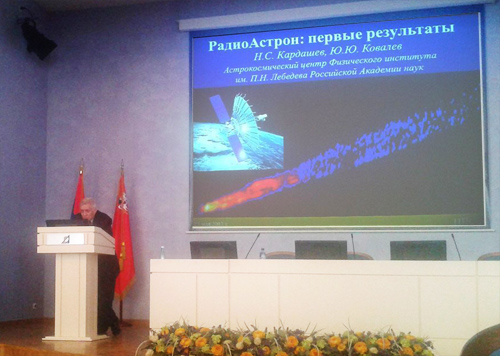
Opening remarks were made by Nikolay Kardashev, Academician of the Russian Academy of Sciences, Director of the Astro-Space Center of FIAN. It is noteworthy that he was one of the pioneers of space radiointerferometry in 1965. That is, he managed to go from: "And we could try this principle to make the device," to "See what a cool device we have turned out." In basic science, not everyone can do this.
When the main part of the report began, I felt myself in a different reality and in a different time. For a second, I ended up in the USSR in the 70s, when Soviet scientists used an everyday voice to tell about any research of world importance at the forefront of science. But no, of what, but routine was not in the words of the doctor of physical and mathematical sciences Yuri Kovalev. I have not seen for a long time a Russian scientist, who was bursting with enthusiasm and pride for the kind of research they are conducting. Probably with such pride, schoolchildren in front of classmates with a new iPhone boast with what a learned physicist told space engineers and designers about their very apparatus.
Before proceeding to the description of the results and achievements of Radioastron, it is necessary to explain the theoretical part. Without preparation, for most, all these interferometers, microseconds and bases in the diameters of the Earth look like an incomprehensible set of words. The explanation of the principles of work and the first results of the research did not fit in the scope of one article, so I divided it into two and so far only a prelude. But after reading it will be possible to finally understand what the scientists wanted to say in their press releases .
According to the principle of operation, a radio telescope actually corresponds to a conventional reflecting telescope with a parabolic mirror, only it collects electromagnetic waves in another range. Accordingly, the characteristics of telescopes are determined in a similar way. Since optical telescopes are much clearer, I used them as an analogy.
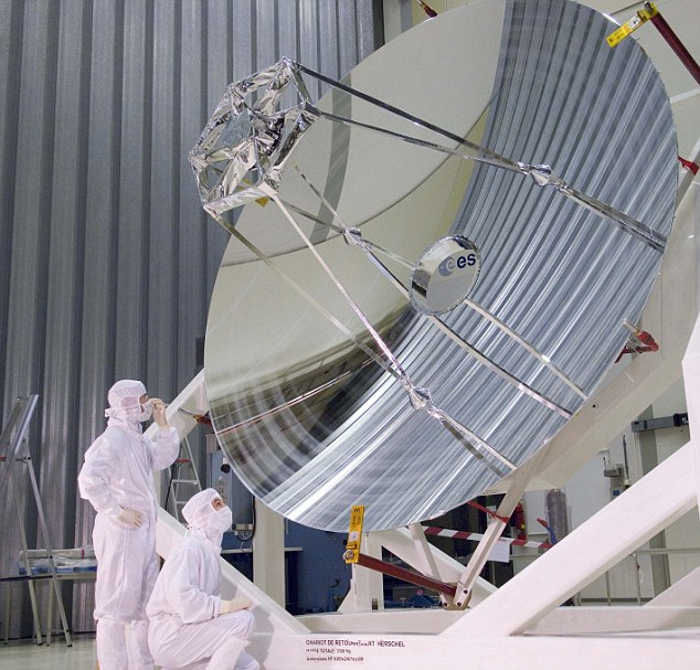
The most important indicator of the telescope - resolution. Now the resolution of cameras is customary to indicate in pixels. But the concept of the resolution of the telescope appeared long pixels.
The resolution of the telescope is expressed in its ability to separate one point from another in the image, and is measured in angular seconds or arc seconds. The firmament is circumferentially divided into 360 degrees, 1 degree for 60 minutes, 1 minute for 60 seconds, followed by tenths, hundredths, thousandths, etc.
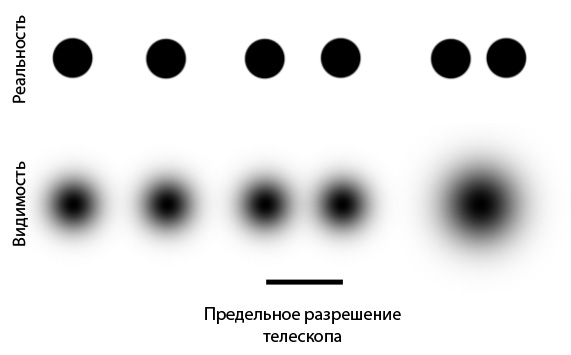
The resolution of the human eye is 1 angular minute, the apparent diameter of the moon is 30 minutes, the limiting resolution of ground-based telescopes is approximately 1 second, the resolution of the Hubble telescope is 0.05 seconds.
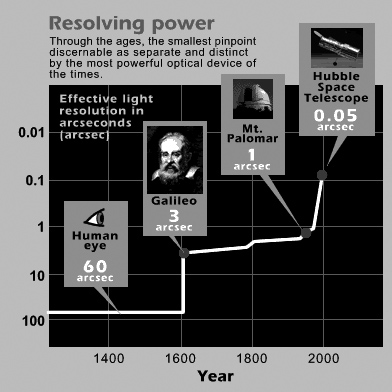
The larger the diameter of the telescope, the higher its resolution, the farther and more detailed you can look. The diameter of the Hubble - 2.4 meters is inferior to many terrestrial telescopes, but its advantage is that it eliminates the distorting influence of the atmosphere.
Radio telescopes "see" in the radio band, they are not so disturbed by the atmosphere, as is another physical limitation. The resolution (diffraction limit) is determined by the formula φ = λ / D (the resolution is equal to the ratio of the wavelength to the diameter of the receiving mirror). The waves of the optical range are very short, so a small mirror already greatly enhances the visual abilities of a person. Radio waves are several orders of magnitude longer, so, for example, at a wavelength of 3 cm, a huge 100-meter dish of a radio telescope will give permission ... like a human eye.

Quickly realizing this lack of scientists began to use the method of interferometry . Without going into details, I will explain in general terms the principle of its action. Interferometry is the reception of a signal from one source to two or more receiving instruments. The resulting resolution of the signal is directly proportional to the distance between the receiving devices. The principle of operation of the interferometer can be visualized by the example of our eyes: two “receiving instruments” look at one object, and one picture is formed in the brain.
Interferometry is used both in optical astronomy (for example on a VLT ) and in radio.
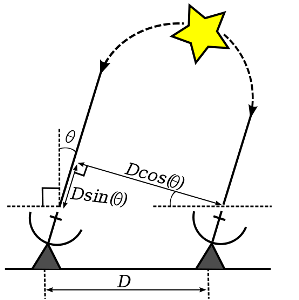
For an interferometer, it is very important to accurately reduce or synchronize signals into one using aperture synthesis in order to obtain the expected result of increased accuracy.
The first radio interferometers were connected by cable, and worked synchronously, as a single mechanism. It simplified the work, but imposed restrictions on the size.
In 1965, Soviet scientists L. I. Matveenko, N. S. Kardashev, and G. B. Sholomitsky suggested using a computer for converging signals. That is, the need for a cable has disappeared, and it has become possible to use radio telescopes even on different continents. This made it possible to open a new milestone in radio astronomy — radio interferometry with super-long bases (VLBI). The “base” in the interferometer is the same as the “diameter” in a single antenna / mirror.
The logical limit for this method of studying the universe has become the size of the Earth.
The resolution of such a conditional “plate” with a base of 12 thousand km exceeds 100 times the capacity of Hubble.
Comparing optical and radio telescopes, one more important difference should be understood. Radio telescopes do not receive a “picture”. They can only receive information about the signal intensity from the source to which the antenna is directed. That is, in fact, the result of one measurement of the signal gives one single pixel of the future image. The intensity of a radio source (as well as optical) is called brightness, and radio telescopes measure the brightness of various points of the source. From the brightness data of different points then you can make a schematic representation, as, for example, a matrix printer does.
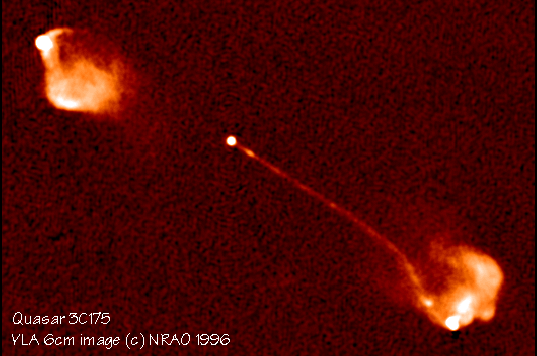
Let's return to radio interferometers. Already since the 70s, the world's largest radio telescopes began to work on the same network. But reaching the limit in the size of the Earth, scientists are thinking about going into space. The first 10-meter radio telescope was installed in the USSR at the Salyut-6 orbital station in 1979. Although he did not work in the interferometer mode, in the same year they decided to create a series of space telescopes, the first of which was Radioastron.
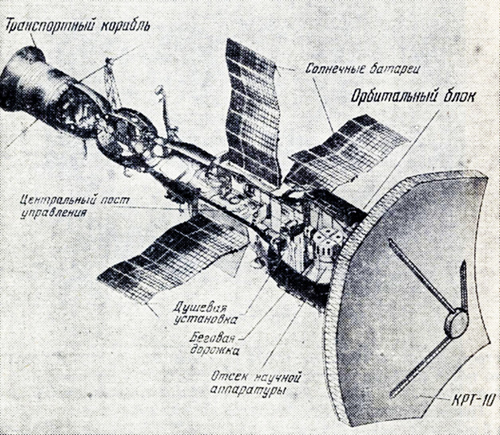
Despite the prospects that were promised by an increase of the radio interferometer base by orders of magnitude, the 1979 project was implemented only in 2011. Prior to this, the Japanese HALCA device flew as an interferometer in the 1990s , and they do not intend to repeat the experience. Now China is going to build two such telescopes.
Radioastron is the name of the entire project of studying the Universe using the radio interferometry method with super-long bases, and the device itself is called Spectr-R.

It carries on board more than two and a half tons of scientific equipment and is, to date, the farthest independent space expedition of Russia. If in the nearest point of the orbit from the Earth it is separated by 600 km, then in the far one it is about 340 thousand km. Let me remind you: 390 thousand km to the moon.
Formally, taking the distant point of the orbit as a basis, we can say that Radioastron provides the size of the conventional “plate” to an astounding 340 thousand km. It seems that even Arthur Clark did not dream of such scales in his Space Odyssey. But, in fact, scientists use shorter bases, which are considered in the diameters of the Earth.
The “Spectr-R” antenna has a diameter of 10 m and the very fact of launching and successfully opening such a structure is an engineering feat. I think at the time of opening of the antenna, in the MCC, there were no less emotions than in NASA at the time of landing Curiosity. It is a pity that we did not see it. To some extent, the tension and importance of that moment can be conveyed by a topic on the Radioastron News Forum on Cosmonautics News.
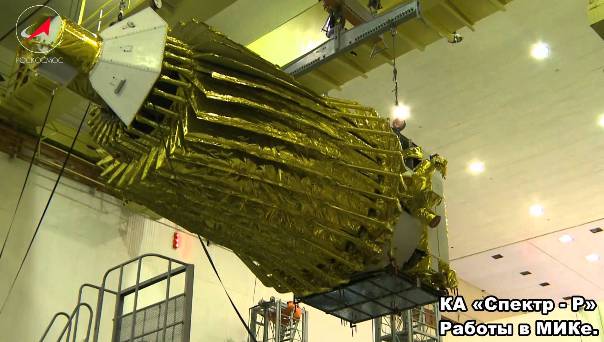
The radio telescope conducts observations on four wavelengths: 92 cm, 18, cm, 6 cm and 1.3 cm. Different ranges allow for the realization of various scientific tasks.
In order to successfully operate in the interferometer mode, Radioastron needs a pair on Earth. And today all the largest radio telescopes of the world participate in the research program.
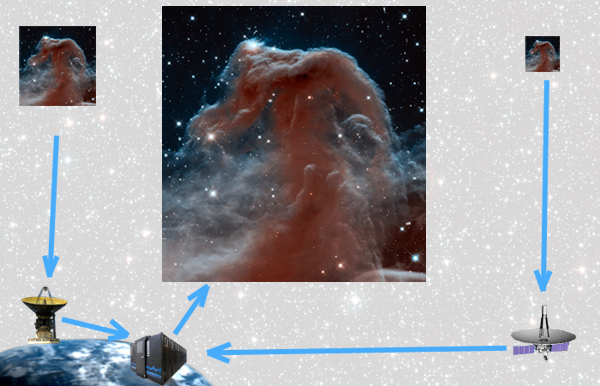
There is one important difference between the work of radio telescopes on the Earth and the work of the pair “Spectr-R” - Earth - the spacecraft flies at a speed of about 8 km / s. Therefore, in order to reduce the two signals, it is necessary to know exactly its location at the time of the observations. To do this, its trajectory is regularly determined by laser rangefinders, and on board are installed very accurate atomic clocks (hydrogen frequency standard). And still, accurate mixing of two signals is a very important point, which is not always possible to reach, and the interference peak (“lobe”) always causes joy to radio astronomers.
If we return to the optical analogies, then the result of unsuccessful observations can be presented in the form of a picture that has evolved from two with an offset, and the true picture can no longer be seen.
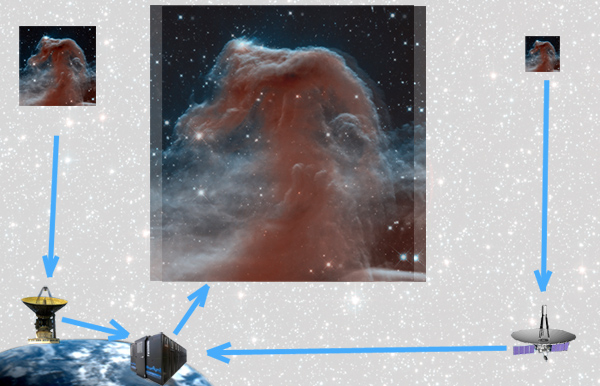
In light of this, it is especially important that the “petal” was obtained almost immediately during the first tests at a wavelength of 18 cm paired with a hundred-meter plate in Germany.
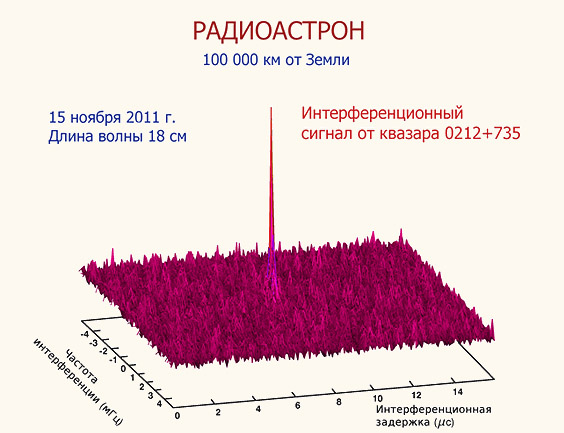
The frequency of 1.3 cm caused much more complications. The reason is the shortness of the wave. It promises the highest resolution, but at the same time imposes the highest demands on the quality of synchronization of signals from two telescopes. The situation is aggravated by the fact that water vapor has a strong influence on this frequency, and the result strongly depends on the weather above the ground-based telescope at the time of the observations.
During the first tests, it was possible to reduce signals at a frequency of 1.3 cm only from the sixth time, and, as it turned out, the failures occurred not only because of the weather, but also because the atomic clock on the American telescope failed. As a result, the first successful synchronization was carried out only with European telescopes. In this case, the ability of the Spektr-R radio telescope to register the signal at two wavelengths of 6 cm and 1.3 cm at once. On a longer wave, it is easier to catch the lobe, and 6 cm was recorded with the German Observatory, and in the same interval time 1.3 cm with the Dutch radio telescope.
When observing telescopes can accumulate a signal - the longer they look, the more intense the signal they receive. For example, all the famous bright Hubble images were taken during the exposure at several hours ( the longest - 555 hours). With an eye not to see this, even if you fly close to these objects. Radio telescopes are getting worse on Earth. Due to the distorting effect of the atmosphere, the effective time of signal accumulation is about 100 seconds, at a wavelength of 1 cm. During the first tests, another feature of our telescope came to light: the Spektr-R from space showed an effective observation period twice as long.
The continuation, with the results of an early scientific program, follows ...
PS I got into the NPO Lavochkin on the Scientific and Technical Council on Radioastron thanks to Habr. Yes, after Mars-3 and Electro-L, Roskosmos began to read Habr! At least NPO Lavochkina. They promised to provide informational assistance in popularizing their work, so that I will try not to limit myself to just Spectrum-R. Who is easier to follow their work through Vkontakt, now it is possible. I created a group of NGOs Lavochkin , and they promised to help with fresh materials.
PPS Thanks UFO for removing the Cosmonautics hub from offtopic. I did not expect to respond so quickly and positively to my request.

Almost two years have passed since its launch. All this time the preliminary scientific program was conducted. Soon it ends, and Spectrum-R will begin the main scientific program, which promises, if not to shake the universe, then to significantly expand its known boundaries.
May 23 in the NGO them. S.A. Lavochkin passed a scientific and technical council on the topic "Radioastron - the first scientific data." In fact, it was the report of the scientists who ordered the device to those who built it.
')
Journalists were not invited there, because some scientific results are still waiting to be published in Nature and other world scientific journals, and they have a strict requirement that the result should not be spotted anywhere. You can talk at conferences. And only somewhere in the press appeared - everything, you can start new research. Therefore, even I will not tell all that I heard.

Opening remarks were made by Nikolay Kardashev, Academician of the Russian Academy of Sciences, Director of the Astro-Space Center of FIAN. It is noteworthy that he was one of the pioneers of space radiointerferometry in 1965. That is, he managed to go from: "And we could try this principle to make the device," to "See what a cool device we have turned out." In basic science, not everyone can do this.
When the main part of the report began, I felt myself in a different reality and in a different time. For a second, I ended up in the USSR in the 70s, when Soviet scientists used an everyday voice to tell about any research of world importance at the forefront of science. But no, of what, but routine was not in the words of the doctor of physical and mathematical sciences Yuri Kovalev. I have not seen for a long time a Russian scientist, who was bursting with enthusiasm and pride for the kind of research they are conducting. Probably with such pride, schoolchildren in front of classmates with a new iPhone boast with what a learned physicist told space engineers and designers about their very apparatus.
Before proceeding to the description of the results and achievements of Radioastron, it is necessary to explain the theoretical part. Without preparation, for most, all these interferometers, microseconds and bases in the diameters of the Earth look like an incomprehensible set of words. The explanation of the principles of work and the first results of the research did not fit in the scope of one article, so I divided it into two and so far only a prelude. But after reading it will be possible to finally understand what the scientists wanted to say in their press releases .
According to the principle of operation, a radio telescope actually corresponds to a conventional reflecting telescope with a parabolic mirror, only it collects electromagnetic waves in another range. Accordingly, the characteristics of telescopes are determined in a similar way. Since optical telescopes are much clearer, I used them as an analogy.

The most important indicator of the telescope - resolution. Now the resolution of cameras is customary to indicate in pixels. But the concept of the resolution of the telescope appeared long pixels.
The resolution of the telescope is expressed in its ability to separate one point from another in the image, and is measured in angular seconds or arc seconds. The firmament is circumferentially divided into 360 degrees, 1 degree for 60 minutes, 1 minute for 60 seconds, followed by tenths, hundredths, thousandths, etc.

The resolution of the human eye is 1 angular minute, the apparent diameter of the moon is 30 minutes, the limiting resolution of ground-based telescopes is approximately 1 second, the resolution of the Hubble telescope is 0.05 seconds.

The larger the diameter of the telescope, the higher its resolution, the farther and more detailed you can look. The diameter of the Hubble - 2.4 meters is inferior to many terrestrial telescopes, but its advantage is that it eliminates the distorting influence of the atmosphere.
Radio telescopes "see" in the radio band, they are not so disturbed by the atmosphere, as is another physical limitation. The resolution (diffraction limit) is determined by the formula φ = λ / D (the resolution is equal to the ratio of the wavelength to the diameter of the receiving mirror). The waves of the optical range are very short, so a small mirror already greatly enhances the visual abilities of a person. Radio waves are several orders of magnitude longer, so, for example, at a wavelength of 3 cm, a huge 100-meter dish of a radio telescope will give permission ... like a human eye.

Quickly realizing this lack of scientists began to use the method of interferometry . Without going into details, I will explain in general terms the principle of its action. Interferometry is the reception of a signal from one source to two or more receiving instruments. The resulting resolution of the signal is directly proportional to the distance between the receiving devices. The principle of operation of the interferometer can be visualized by the example of our eyes: two “receiving instruments” look at one object, and one picture is formed in the brain.
Interferometry is used both in optical astronomy (for example on a VLT ) and in radio.

For an interferometer, it is very important to accurately reduce or synchronize signals into one using aperture synthesis in order to obtain the expected result of increased accuracy.
The first radio interferometers were connected by cable, and worked synchronously, as a single mechanism. It simplified the work, but imposed restrictions on the size.
In 1965, Soviet scientists L. I. Matveenko, N. S. Kardashev, and G. B. Sholomitsky suggested using a computer for converging signals. That is, the need for a cable has disappeared, and it has become possible to use radio telescopes even on different continents. This made it possible to open a new milestone in radio astronomy — radio interferometry with super-long bases (VLBI). The “base” in the interferometer is the same as the “diameter” in a single antenna / mirror.
The logical limit for this method of studying the universe has become the size of the Earth.
The resolution of such a conditional “plate” with a base of 12 thousand km exceeds 100 times the capacity of Hubble.
Comparing optical and radio telescopes, one more important difference should be understood. Radio telescopes do not receive a “picture”. They can only receive information about the signal intensity from the source to which the antenna is directed. That is, in fact, the result of one measurement of the signal gives one single pixel of the future image. The intensity of a radio source (as well as optical) is called brightness, and radio telescopes measure the brightness of various points of the source. From the brightness data of different points then you can make a schematic representation, as, for example, a matrix printer does.

Let's return to radio interferometers. Already since the 70s, the world's largest radio telescopes began to work on the same network. But reaching the limit in the size of the Earth, scientists are thinking about going into space. The first 10-meter radio telescope was installed in the USSR at the Salyut-6 orbital station in 1979. Although he did not work in the interferometer mode, in the same year they decided to create a series of space telescopes, the first of which was Radioastron.

Despite the prospects that were promised by an increase of the radio interferometer base by orders of magnitude, the 1979 project was implemented only in 2011. Prior to this, the Japanese HALCA device flew as an interferometer in the 1990s , and they do not intend to repeat the experience. Now China is going to build two such telescopes.
Radioastron is the name of the entire project of studying the Universe using the radio interferometry method with super-long bases, and the device itself is called Spectr-R.

It carries on board more than two and a half tons of scientific equipment and is, to date, the farthest independent space expedition of Russia. If in the nearest point of the orbit from the Earth it is separated by 600 km, then in the far one it is about 340 thousand km. Let me remind you: 390 thousand km to the moon.
Formally, taking the distant point of the orbit as a basis, we can say that Radioastron provides the size of the conventional “plate” to an astounding 340 thousand km. It seems that even Arthur Clark did not dream of such scales in his Space Odyssey. But, in fact, scientists use shorter bases, which are considered in the diameters of the Earth.
The “Spectr-R” antenna has a diameter of 10 m and the very fact of launching and successfully opening such a structure is an engineering feat. I think at the time of opening of the antenna, in the MCC, there were no less emotions than in NASA at the time of landing Curiosity. It is a pity that we did not see it. To some extent, the tension and importance of that moment can be conveyed by a topic on the Radioastron News Forum on Cosmonautics News.

The radio telescope conducts observations on four wavelengths: 92 cm, 18, cm, 6 cm and 1.3 cm. Different ranges allow for the realization of various scientific tasks.
In order to successfully operate in the interferometer mode, Radioastron needs a pair on Earth. And today all the largest radio telescopes of the world participate in the research program.

There is one important difference between the work of radio telescopes on the Earth and the work of the pair “Spectr-R” - Earth - the spacecraft flies at a speed of about 8 km / s. Therefore, in order to reduce the two signals, it is necessary to know exactly its location at the time of the observations. To do this, its trajectory is regularly determined by laser rangefinders, and on board are installed very accurate atomic clocks (hydrogen frequency standard). And still, accurate mixing of two signals is a very important point, which is not always possible to reach, and the interference peak (“lobe”) always causes joy to radio astronomers.
If we return to the optical analogies, then the result of unsuccessful observations can be presented in the form of a picture that has evolved from two with an offset, and the true picture can no longer be seen.

In light of this, it is especially important that the “petal” was obtained almost immediately during the first tests at a wavelength of 18 cm paired with a hundred-meter plate in Germany.

The frequency of 1.3 cm caused much more complications. The reason is the shortness of the wave. It promises the highest resolution, but at the same time imposes the highest demands on the quality of synchronization of signals from two telescopes. The situation is aggravated by the fact that water vapor has a strong influence on this frequency, and the result strongly depends on the weather above the ground-based telescope at the time of the observations.
During the first tests, it was possible to reduce signals at a frequency of 1.3 cm only from the sixth time, and, as it turned out, the failures occurred not only because of the weather, but also because the atomic clock on the American telescope failed. As a result, the first successful synchronization was carried out only with European telescopes. In this case, the ability of the Spektr-R radio telescope to register the signal at two wavelengths of 6 cm and 1.3 cm at once. On a longer wave, it is easier to catch the lobe, and 6 cm was recorded with the German Observatory, and in the same interval time 1.3 cm with the Dutch radio telescope.
When observing telescopes can accumulate a signal - the longer they look, the more intense the signal they receive. For example, all the famous bright Hubble images were taken during the exposure at several hours ( the longest - 555 hours). With an eye not to see this, even if you fly close to these objects. Radio telescopes are getting worse on Earth. Due to the distorting effect of the atmosphere, the effective time of signal accumulation is about 100 seconds, at a wavelength of 1 cm. During the first tests, another feature of our telescope came to light: the Spektr-R from space showed an effective observation period twice as long.
The continuation, with the results of an early scientific program, follows ...
PS I got into the NPO Lavochkin on the Scientific and Technical Council on Radioastron thanks to Habr. Yes, after Mars-3 and Electro-L, Roskosmos began to read Habr! At least NPO Lavochkina. They promised to provide informational assistance in popularizing their work, so that I will try not to limit myself to just Spectrum-R. Who is easier to follow their work through Vkontakt, now it is possible. I created a group of NGOs Lavochkin , and they promised to help with fresh materials.
PPS Thanks UFO for removing the Cosmonautics hub from offtopic. I did not expect to respond so quickly and positively to my request.
Source: https://habr.com/ru/post/184662/
All Articles